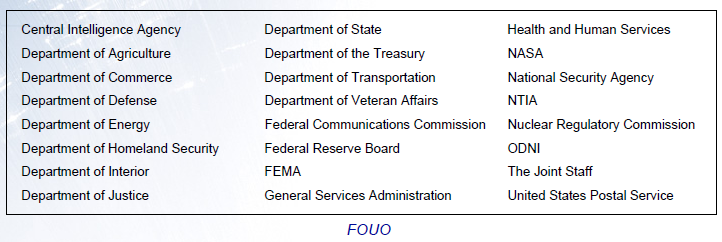National Communications System
- Department of Homeland Security
- Bill Ryan
- Continuity Communications Architecture (CCA) Program Manager
- 13 slides
- For Official Use Only
- June 10, 2008
National Communications System
- Established in 1963 in response to communications failures associated with the Cuban Missile Crisis
- The mandate was redefined through Executive Order 12472
- Comprised of 24 Federal Departments and Agencies
- Executive and administrative oversight is assigned to the Department of Homeland Security
NSPD-51/HSPD-20 is a policy that kicks off a comprehensive review cycle of all D/As Primary Mission Essential Functions (PMEFs) and their ability to support NEFs. The review will culminate in a set of continuity requirements effecting leadership, staff, communications and facilities.
The National Communications System is responsible for assuring key national security and emergency preparedness (NS/EP) decision-makers have the ability to communicate through the full spectrum of crises.
With the vast majority of the communications infrastructure owned by corporations, any successful strategy requires regular and meaningful interaction with industry.Committee of Principals
- 24 Federal Departments and Agencies
- Forum to evaluate current and future NS/EP programs
- Meetings are chaired by Manager, NCS
National Security Telecommunications Advisory Committee
- Executives of major communications and network services corporations
- Provides advice to the President on NS/EP communication policy
- NCS provides NSTAC with staff support and technical assistance
As an interagency “system,” the NCS has a unique reporting relationship with the Executive Office of the President.
Interaction with the communications industry is vital in response to a disaster National Coordinating Center (NCC) for Telecommunications
• Joint Industry/government operation
• Focal point for restoration of the communications infrastructure during disasters
• Over 40 industry representatives make up the Communications Information Sharing and Analysis Center
• Operates the 24X7 NCC Watch
Because access to the public communications network is often degraded in times of crisis, the NCS has developed programs to ensure priority access for critical users.
- Government Emergency Telecommunications Service (GETS)
- Priority access to the public wireline network
- GETS is supported by all major service providers
- Eligible users span from National Security leadership to emergency responders
- Over 180,000 users
- Wireless Priority Service (WPS)
- Priority access to the public wireless network
- WPS is available through AT&T, Edge Wireless, SouthernLINC, Sprint/Nextel, T-Mobile and Verizon
- Eligible users span from National Security leadership to emergency responders
- Over 70,000 users
- Telecommunications Service Priority (TSP)
- Establishes priority for the restoration and provisioning of critical NS/EP circuits
- Supported by an FCC regulatory mandate
- Emergency Support Function #2, Communications
- National Response Framework designates the NCS as Coordinating Agency for ESF #2
- National Coordinating Center is the focal point for government/Industry interaction during emergency response
- Accomplished through a partnership with Federal agencies (DOA, DOC, DOD, DHS, DOI, FCC, GSA) and industry partners
- Shared Resources High Frequency Radio Program (SHARES)
- Providing a single, interagency message handling system with no reliance on the public network
- User community includes over 1,000 stations from over 90 Federal, State and industry organizations worldwide
In order to effectively plan for a resilient communication capability, the NCS must have a deep understanding of the public communications network.
- Network Design and Analysis Capability (NDAC)
- Enables modeling and analysis of the public switched network
- Assist in the identification of network vulnerabilities
- Provide a laboratory test bed for emerging technologies
- Perform scenario analysis for specific threats
- Analysis Response Team (ART)
- Provide tailored analytical products to support decision making in advance of and during incidents of national significance
- Focused on tactical, operational analyses
- Route Diversity Project (RDP)
- Provide technical and regulatory information to help increase the resiliency of their telecommunication networks
- Focused on “last-mile” connectivity between government facilities and telecom providers
- Provide methodology and mitigation solutions sets
- Advance Technologies Group
- Conduct Next Generation Network communications infrastructure Telecommunications Electromagnetic Disruptive Effects (TEDE) vulnerability studies.
- Analyze a broad range of concerns inherent in the communications sector’s dependence on reliable operation of the electric power sector
…
National Communications System Directive 3-10, Minimum Requirements for Continuity Communications Capabilities, established minimum requirements to facilitate assured communications between the President, the President’s staff, Executive office of the President personnel, Cabinet Secretaries (Executive Departments) and other senior leadership during a crisis
NCSD 3-10 is a set of communication requirements that all FEB departments and agencies must immediately begin to procure, install, maintain, test and operate.National Security Presidential Directive 51/Homeland Security President Directive 20 (NSPD-51/HSPD-20), National Continuity
Policy, established a comprehensive program designed to ensure survival of our constitutional form of government and the continuation of the performance of National Essential Functions (NEFs) under all conditions


